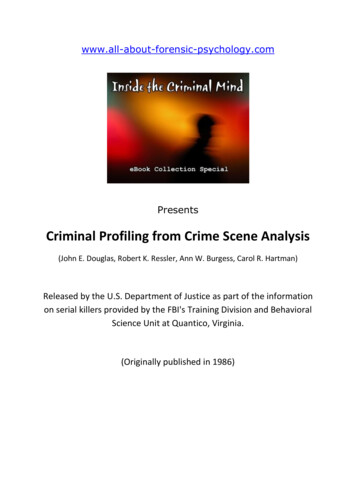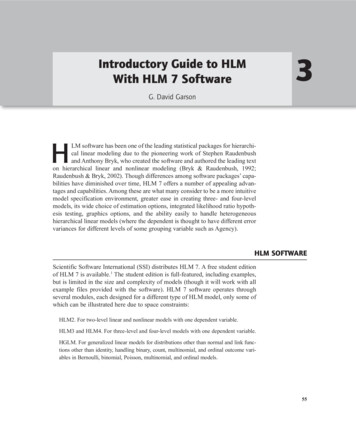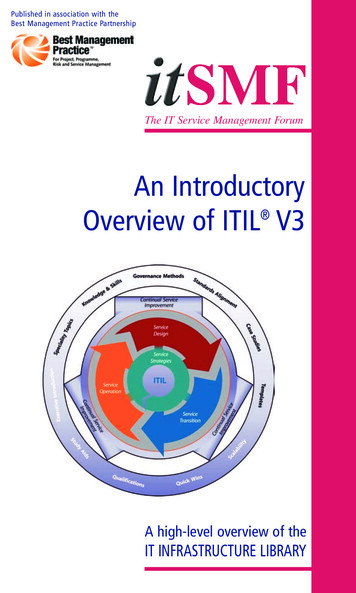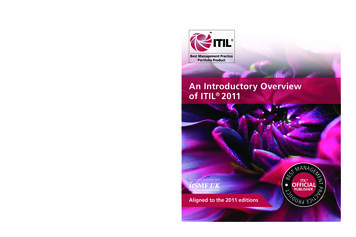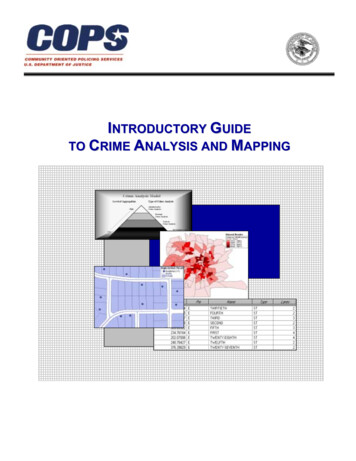
Transcription
INTRODUCTORY GUIDETO CRIME ANALYSIS AND MAPPING
Introductory Guide to Crime Analysis and MappingWritten by:Rachel Boba, Ph.D.Director, Crime Mapping LaboratoryPolice FoundationNovember 2001Report to the Office of Community Oriented Policing ServicesCooperative Agreement #97-CK-WXK-004The opinions, findings, and conclusions or recommendations expressed inthis document are those of the authors and do not necessarily represent theofficial position or policies of the U.S. Department of Justice.
AcknowledgementsAcknowledgementsThe author would like to thank Kristin Quayle for transcribing our trainingsession during her summer here at the Police Foundation, as well as MaryVelasco and Erin Lane, Research Associates at the Police Foundation, fortheir careful review and comments.3
Table of ContentsPageI. Introduction. 8II. Introduction to Crime Analysis . 9Definition of Crime Analysis. 9Types of Crime Analysis . 11Intelligence Analysis . 11Criminal Investigative Analysis . 12Tactical Crime Analysis. 13Strategic Crime Analysis. 13Administrative Crime Analysis . 14Crime Analysis Model . 15III. Introduction to Crime Mapping . 17Historical Overview . 17Types of Mapping . 18Manual Pin Mapping . 18Computer Mapping . 19Geographic Information System (GIS) . 19Crime Analysis Mapping . 20GIS Components. 20Data representation. 20Point feature . 20Line feature . 21Polygon feature . 21Image feature . 22Data of geographic features . 23Point data . 23Line data. 24Polygon data . 244
Table of ContentsPageGIS toolbox . 25Connectivity. 25Contiguity . 26Geometry. 26Visual display/mapping . 27Thematic approach. 27Scale . 28Querying GIS data . 31Tabular queries . 31Spatial queries. 32IV. Introduction to Problem Solving . 34Definition of Problem Solving . 34SARA Approach to Problem Solving . 34Scanning. 34Analysis . 34Response. 35Assessment. 35Crime Analysis and Problem Solving . 36V. Data and Geocoding . 37Types of Data . 37Tabular Data . 37Geographic Data . 37General Data Integrity Issues . 38Data Entry. 38Timeliness . 38Data Validity . 38Reliability. 39Data Transfer Process. 39Data Confidentiality/Privacy . 395
Table of ContentsPageData Management. 40Metadata . 40Geocoding . 40Introduction . 40The geocoding process. 41Step 1: Prepare the geographic andtabular files for geocoding. 41Step 2: Specify geocoding parameters. 45Step 3: Geocode . 46Step 4: Review results. 48Step 5: If necessary, respecify parametersand geocode again. . 50Conclusion . 51VI. Spatial Analysis Techniques. 52Single Symbol Mapping . 52Graduated Mapping. 55Graduation By Size . 55Graduation By Color. 57Classification Methods. 59Natural breaks. 59Quantile. 60Equal area. 61Equal interval . 62Standard deviation . 63Custom. 65VII. Crime Analysis Product Formatand Dissemination. 67Factors to Consider. 67Methods of Dissemination . 67Components of Crime Analysis Products . 686
Table of ContentsPageTypes of Crime Analysis Products . 68General Crime Analysis Product Elements . 70Map Design Elements. 71Evaluating the Utility of Crime Analysis and Mapping Products . 73VIII. References . 747
IntroductionI. IntroductionThe following guide was developed from the curriculum for the “Introduction toCrime Analysis Mapping and Problem Solving” training course conducted bymembers of the Police Foundation’s Crime Mapping Laboratory in 2001 and fundedby the Office of Community Oriented Policing Services (COPS). The purpose of thisdocument is to convert the information presented in the training into a succinct andreadable report that makes it available to a larger audience than was reached throughthe training sessions. It is not intended to be a comprehensive document on crimeanalysis, crime mapping, and problem solving, but rather a “starter” guidebook forsomeone just entering the field or a reference manual for current crime analysts orother law enforcement analysts. The format of the document follows the format ofthe training slides loosely, but it is not necessary to read them together. Thisdocument stands on its own. For further reading on crime analysis and mapping, seeother relevant documents written by the Police Foundation atwww.policefoundation.org or www.cops.usdoj.gov.8
Introduction to Crime AnalysisII. Introduction to Crime AnalysisAs an introduction to crime analysis, this section provides the definition of crimeanalysis as a general concept as well as definitions of five types of crime analysis.These definitions are used in the Police Foundation’s “Introduction to Crime AnalysisMapping and Problem Solving” course and have been created to synthesize currentconcepts and ideas in the field of crime analysis. These definitions are meant toenhance the understanding of crime analysis and to help create commonly understoodterminology. The latter part of this section includes a hierarchical model by which allfive types of crime analysis are related to one another.Definition of Crime AnalysisThe qualitative and quantitative study of crime and law enforcementinformation in combination with socio-demographic and spatial factorsto apprehend criminals, prevent crime, reduce disorder, and evaluateorganizational procedures.Qualitative and quantitative. Crime analysis uses both qualitative andquantitative data and analytical techniques. Qualitative data and analyticaltechniques refer to non-numerical data as well as the examination and interpretationof observations for the purpose of discovering underlying meanings and patterns ofrelationships. This is most typical of field research, content analysis, and historicalresearch. Quantitative data are data primarily in numerical or categorical format.Quantitative analysis consists of manipulations of observations for the purpose ofdescribing and explaining the phenomena that those observations reflect and isprimarily statistical. Crime analysis employs both types of data and techniquesdepending on the analytical and practical need. For example, crime data can be usedin various ways, both quantitatively and qualitatively. The information such as date,time, location, and type of crime is quantitative in that statistics can be used toanalyze these variables. On the other hand, narratives of crime reports are consideredqualitative data in that a large number of narratives are nearly impossible to analyzestatistically and are primarily examined to determine general themes and patterns.Study. Study is a systematic way of looking at crime and law enforcementinformation. That is, crime analysis is not examining information haphazardly butrather is applying formal analytical and statistical techniques as well as researchmethodology to law enforcement information according to the rules of social science.9
Introduction to Crime AnalysisCrime. In a law enforcement agency, the central focus is crime, both those reportedto the police and those that are not. Thus, the central type of data analyzed is crimeand the information surrounding it, such as arrests, offenders, victims, property, andevidence.Law enforcement information. In addition to crime, law enforcement agenciesaddress many other issues and thus collect many other types of data. Examples oflaw enforcement data that are often available for crime analysts are calls for service(e.g., noise complaints, burglary alarms, suspicious activity), traffic information (e.g.,accidents and citations), citizens’ perceptions (e.g., fear of crime, crime preventionbehavior, satisfaction with the police), victimization, probation records, and paroleinformation.In combination with This phrase refers to identifying patterns and studyingrelationships of crime and law enforcement data with other types of information, suchas those listed below.Socio-demographic. This type of information refers to characteristics ofindividuals and groups such as sex, race, income, age, and education. On anindividual (micro) level, socio-demographic information is used in law enforcementto search for and identify crime suspects. On a macro level, socio-demographicinformation is used to determine the characteristics of groups and how they relate tocrime. For example, the information may be used to answer the questions, “Wherecan we find the suspect who is a white male, 30-35 years of age with brown hair andbrown eyes?” or “Can demographic characteristics explain why one neighborhood hasa higher rate of crime than another?”Spatial. The location where crimes or activities occur and the relationship of thoseplaces to one another and to other information is an important factor in the analysis ofcrime. It is not only important where a crime takes place but also the characteristicsof those places and the environment in which the crime occurs. Thus, examination ofspatial data such as streets networks, parcel information, orthophotographs, schoollocations, business and residential zoning, among others, is imperative for effectivecrime analysis.The last four key points describe the four goals of crime analysis.Apprehending criminals. The main function of crime analysis is to support lawenforcement endeavors. One of the primary goals of law enforcement is theapprehension of criminals; consequently, one of the primary goals of crime analysis isto assist in the apprehension of criminals. For example, a detective may have arobbery incident in which the suspect has a snake tattoo on his left arm. The crimeanalysts may assist by searching a database of field incident cards to identify10
Introduction to Crime Analysisindividuals with such a tattoo. Also, a crime analyst may conduct a time of day/dayof week analysis of burglary incidents that would assist officers in surveillance of anarea to catch offenders.Prevent crime. Another primary goal of law enforcement is to prevent crimethrough methods other than apprehension. This goal lends itself particularly well toassistance from crime analysis. For example, members of the police department areconducting a crime prevention campaign about residential burglary and would like totarget their resources in the areas that need it the most. Crime analysis can assist inplanning community education and patrol response tailored to the problem byproviding spatial analysis of residential burglary, analysis of how, when, and wherethe burglaries occurred, and analysis of what items were stolen. This informationcould be used to develop crime prevention suggestions such as closing and locking agarage door.Reduce disorder. Many criminologists contend that social disorder can lead tocrime; that is, blight and other indicators of social decay left unchecked can attractcrime and accelerate further decay. Thus, reducing disorder is a law enforcementobjective and, by extension, one for crime analysis as well. Crime analysis can assistwith these efforts by providing research and analysis of disorder indicators such astraffic accidents, noise complaints, or trespass warnings that can assist officers inaddressing these issues before they become more serious problems.Evaluate organizational procedures. The fourth goal of crime analysis isassisting with the evaluation of organizational procedures. Several examples includeresource allocation, the assessment of crime prevention programs, realigninggeographic boundaries, forecasting staffing needs, and developing performancemeasures for the police department.Types of Crime AnalysisThe following are five types of analysis that fall under the umbrella of crime analysis.As you will see, each contains characteristics of crime analysis in general, but each isspecific in the type of data and analysis used as well as in its purpose.Intelligence AnalysisThe study of “organized” criminal activity, whether or not it is reportedto law enforcement, to assist investigative personnel in linking people,events, and property.The purpose of intelligence analysis is to assist sworn personnel in the identificationof networks and apprehension of individuals to subsequently prevent criminal11
Introduction to Crime Analysisactivity. A related goal is to link information together, prioritize information,identify relationships, and identify areas for further investigation by putting theanalysis in a framework that is easy to understand. Much of the information analyzedin the field of intelligence analysis is not reported to the police by citizens but isgathered by law enforcement. Examples of data collection methods includesurveillance, informants, and participant observation. In addition, the type ofinformation is not limited to criminal information but can include telephoneconversations, travel information, financial/tax information, and family and businessrelationships. Intelligence analysis has traditionally focused more or less onorganized criminal activity, which includes drugs and prostitution syndicates. Thedata analyzed are plentiful and primarily qualitative, and thus are usually analyzedthrough qualitative methods. In light of the events of September 11, 2001,intelligence analysis has most recently begun to focus on terrorist activity at the locallevel as well.Criminal Investigative AnalysisThe study of serial criminals, victims, and/or crime scenes as well asphysical, socio-demographic, psychological, and geographiccharacteristics to develop patterns that will assist in linking togetherand solving current serial criminal activity.This type of analysis has also been called “profiling,” which is the process ofconstructing a “profile” of an unknown offender based on the nature of the crime, thefacts of the case, and the characteristics of the victim. As with intelligence analysis,this type of analysis focuses primarily on qualitative data surrounding serious serialcrimes such as murder and rape. Data are collected and analyzed on an individuallevel for those persons primarily or peripherally involved with the incidents. Thespatial nature of the incidents and related locations such as the body dump sites or theencounter sites is also considered. The primary purpose of criminal investigativeanalysis is to develop patterns of serial crimes crossing city, state, and even nationalboundaries by linking behavior and evidence within and among incidents in order tocatch the offender and/or clear cases. This is a very specific type of crime analysisthat is primarily done on the federal law enforcement level since these types of crimeoccur infrequently and cross jurisdictional boundaries.12
Introduction to Crime AnalysisTactical Crime AnalysisThe study of recent criminal incidents and potential criminal activity byexamining characteristics such as how, when, and where the activityhas occurred to assist in problem solving by developing patterns andtrends, identifying investigative leads/suspects, and clearing cases.Tactical crime analysis focuses on information from recent crimes reported to thepolice. “Recent” can refer to the last few months or longer periods of time forspecific ongoing problems. Tactical crime analysis also focuses on specificinformation about each crime such as method of entry, point of entry, suspectsactions, type of victim, type of weapon used, as well as the date, time, location, andtype of location. Field information such as suspicious activity calls for service,criminal trespass warnings, and persons with scars, marks, or tattoos collected byofficers is also considered in the analysis. Although quantitative analysis is oftenconducted once a pattern has been identified, qualitative analysis, (i.e., criticalthinking and content analysis) is used to identify patterns and trends initially. Threepurposes of tactical crime analysis are 1) linking cases together and identifying thenotable characteristics of the patterns and trends, 2) identifying potential suspects of acrime or crime pattern, and 3) clearing cases. The focus of tactical crime analysis isexamining data daily in order to identify patterns, trends, and investigative leads forrecent criminal and potential criminal activity. Once a crime pattern, suspect, orinvestigative lead is identified, the information is compiled and disseminated to patrolofficers and detectives.Strategic Crime AnalysisThe study of crime and law enforcement information integrated withsocio-demographic and spatial factors to determine long term“patterns” of activity, to assist in problem solving, as well as to researchand evaluate responses and procedures.Strategic crime analysis consists primarily of quantitative analysis of aggregate data.Monthly, quarterly, and/or yearly compilations of criminal and non-criminalinformation such as crime, calls for service, and traffic information are analyzed inaggregate form. That is, general categories such as date, time, location, and type ofincident are analyzed instead of qualitative data such as narrative descriptions ofincidents. Variables including race, class, sex, income, population, location, andlocation type are examined along with law enforcement information in the analysisprocess. The two primary purposes of strategic crime analysis are 1) to assist in theidentification and analysis of long-term problems such as drug activity or auto theftand 2) to conduct studies to investigate or evaluate relevant responses and procedures.Both of these purposes correspond very well to the problem solving process (see13
Introduction to Crime AnalysisSection IV for a discussion of crime analysis and problem solving specifically).These types of studies include evaluation of crime prevention programs, in depthexamination of a particular crime problem, and implementation of a survey ofcitizens’ perceptions of crime and the police. They incorporate pre- and postmeasurement as well as both impact and process evaluation methodology. Proceduresexamined include such activities as deployment and staffing, redistricting of beats orprecincts, data entry and integrity, and the reporting process. In sum, strategic crimeanalysis uses statistical techniques and research methods to investigate long-termproblems and evaluate organizational procedures. Analysts who primarily conductstrategic crime analysis are also called problem or research analysts.Administrative Crime AnalysisThe presentation of interesting findings of crime research and analysisbased on legal, political, and practical concerns to inform audienceswithin law enforcement administration, city government/council, andcitizens.Administrative crime analysis is different from the previous types of analysis in that itrefers to presentation of findings rather than to statistical analysis or research. Thedecision of what and how to present information is the primary focus ofadministrative crime analysis. Often, the type of information that is presentedrepresents the “tip of the iceberg” of all the work and analysis that has previouslybeen done, for example, an executive summary of a report. The purpose and theaudience of the information determine “what” is presented along with legal (e.g.,privacy and confidentiality), political (e.g., union issues, election concerns), andpractical concerns (e.g., complexity of the information presented). The primarypurpose of administrative crime analysis is to inform audiences. These audiencesmay vary from one situation to the next, which is why the type and quantity ofinformation should vary as well. Audiences can be police executives, city council,media, citizens, and neighborhood groups or a combination. An excellent example ofadministrative crime analysis is the use of the Internet to provide information to thegeneral public. Audiences of a police Internet site include citizens, police personnel,businesses, victims, criminals, and media—essentially everyone; therefore, the type ofinformation published should be appropriate for an array of diverse customers. Theinformation provided should be simple, clear, and concise and should not disclosesensitive information. One rule of thumb would be to only publish information thatone would be comfortable seeing on the evening news.14
Introduction to Crime AnalysisCrime Analysis ModelThe following figure displays how all of these types of crime analysis relate to oneanother in terms of the level of aggregation of the information. That is, types withlow levels of aggregation focus on individual cases and used qualitative data andanalysis techniques and those with high levels of aggregation focus on a limited scopeof larger amounts of data and information. At the top of the figure, criminalinvestigative analysis and intelligence analysis utilize the least aggregated and mostqualitative data. The data consist of information about informal networks of criminalsand their non-criminal acquaintances and relatives as well as where individuals live,work, and “play.” The focus here is on the specifics of criminals, the nature of theircrimes, their relationships, and their lives in general.Tactical crime analysis utilizes only crimes and activity reported to the police so thedata are more aggregate and somewhat less abundant than those used for criminalinvestigative and intelligence analysis. Tactical crime analysis is primarilyqualitative in nature but depending on the data, quantitative techniques can be used todescribe characteristics of a given pattern such as the most common time the crimesoccur (time series) or where the crimes are located in relationship to one another.Strategic crime analysis utilizes large amounts of data that are even more aggregatedthan tactical and investigative data. For example, information used in tactical crimeanalysis is primarily made up of crime incidents but includes such information asdate, time, location, methods of the crime, and detailed description of the crime.Strategic crime analysis focuses only on those variables that can be easily quantified,such as date, time, location, type of location, type of crime, and priority. Thus, the15
Introduction to Crime Analysistype of analysis is more quantitative and the large amount of data calls for statisticaloperations instead of reading and examining each case individually.Finally, administrative crime analysis in this figure is literally the “tip” of the trianglein level of aggregation. The focus is presenting the most aggregate or summaryinformation to a variety of audiences.Overall, these types of analysis fall under the general definition of crime analysis inthat each one contains some of the key components of crime analysis. For thepurposes of the rest of this report, we will focus on examples of the last three types ofanalysis, tactical, strategic, and administrative, as they are the types of analysis thatare most likely to be conducted on a regular basis by a crime analyst in an averagelaw enforcement agency.16
Introduction to Crime Analysis MappingIII. Introduction to Crime Analysis MappingHistorical OverviewThe following chart is a brief outline of the history of crime mapping (taken fromWeisburd and McEwen, 1997; and Harries, 1999). Mapping itself has a long history,but crime mapping specifically can be traced back to the early 1800s when socialtheorists began to create maps to illustrate their theories and research about crime. Inrelation to crime and policing, maps initially were used to examine issues like povertyor demographic characteristics and crime. One of the first police departments to usemapping was New York City in the 1900s. The maps consisted of simple wall mapsin which “push pins” were used to indicate crimes that had occurred. During the1920s and 1930s, sociologists at the University of Chicago used mapping to examinecrime and delinquency, specifically juvenile delinquency and related socialcharacteristics. In the 1960s and 1970s, the first computer-generated maps of crimewere created. (See Weisburd and McEwen, 1997 for more information).Early 1800s: Social Theorists: Single symbol point andgraduated area maps1900s: New York City Police Department andothers: Single symbol point maps, “pin maps”1920s-30s: Urban sociologists at the University ofChicago: Graduated area maps of crime anddelinquency1960s-70s: First computer generated maps of crime1980s: Desktop computers available for mapping,but with limited quality; EnvironmentalCriminology theory1990s: Desktop GIS and integration with lawenforcement systems and data; governmentfunding, etc.In the 1980s, more advanced technology and desktop computers became available,and more widely used. However, the quality of computerized mapping at that timewas limited because of slow processing speeds and poor printing quality. At the sametime, environmental criminology theory began to emerge, and academics began toexamine the spatial characteris
individuals with such a tattoo. Also, a crime analyst may conduct a time of day/day of week analysis of burglary incidents that would assist officers in surveillance of an area to catch offenders. Prevent crime. Another primary goal of law enforcement is
